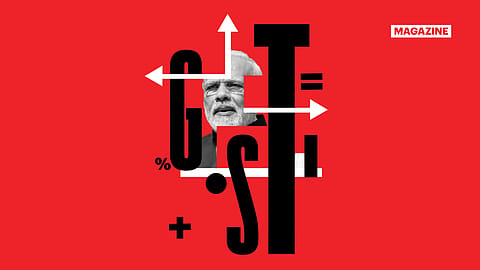PM’s Independence Day roadmap: The reforms season is back with GST 2.0
The next-generation reforms announced by the PM on Independence Day will help India accelerate growth.

This story belongs to the Fortune India Magazine september-2025-the-year-of-ev-launches issue.
RAISINA HILL, the seat of the government in the heart of Lutyen’s Delhi, is abuzz with activity in the wake of Prime Minister Narendra Modi’s announcement of next-generation reforms on Independence Day. The PM has set the reforms bandwagon rolling beginning with a GST rate cut, which he called a Diwali ‘gift’ for citizens. And more initiatives are on the cards to make Indian products competitive globally and expedite economic growth.
The finance ministry has proposed a reduction in GST on essential items to 5% from 12%, and to 18% from 28%. A special slab of less than 5% will continue to promote employment-generating sectors, while a 40% slab has been proposed, which would comprise five to seven sin goods. On August 20, finance minister Nirmala Sitharaman held a meeting with the Group of Ministers (GoM) under the GST Council and said the Central government is committed to building consensus with states on the reforms.
At the time of going to press, the proposals had been approved by the GoM. The lightning speed of approvals — being witnessed for the first time in GST’s history — indicates that the government had been preparing the proposals and working to build consensus with states much ahead of the announcement.
GST reforms, however, are just the beginning as the government is preparing a pipeline for the future. PM Modi, too, held a top-level meeting on the other next-gen reforms within a week of his announcement. He discussed the roadmap for “speedy and comprehensive reforms that will enhance ease of living, improve ease of doing business, and foster inclusive prosperity”, said a government release. “We are committed to speedy reforms across all sectors, which will boost ease of living, ease of doing business, and prosperity,” the PM said in a post on X.
Sources say that multi-faceted reforms are being deliberated upon. A push for MSMEs, job creation, and providing a further fillip to Atmanirbhar Bharat, along with reinvigorating private sector investment, are some of the key areas being deliberated on and will see policy traction going forward.
Another source pointed out that the government’s approach towards reforms is holistic and not piecemeal. “In GST as well, there are multiple isolated issues, like inverted duty structure, compliance, and refunds. All these have been broadly bundled into three pillars and will be addressed at one go. The government’s focus is to reinvigorate the core sectors of the economy,” the source said.
Sources say the next big move will be on regulatory reforms announced in the Budget. “We are determined to ensure that our regulations must keep up with technological innovations and global policy developments. A light-touch regulatory framework based on principles and trust will unleash productivity and employment,” Sitharaman had said in the Budget.
More Stories from this Issue
The private sector, too, seems ready to match the government’s reforms sprint. On August 24, the Confederation of Indian Industry (CII) unveiled its flagship policy blueprint — ‘Policies for a Competitive India’ — listing a comprehensive reforms roadmap, with over 250 actionable recommendations across 14 critical areas. “Over the last decade, India has witnessed historic reforms, including GST, corporate tax rationalisation, digitisation of governance, and progressive trade agreements. However, rising geopolitical shifts and the twin transitions — green and digital — demand that India further deepens reforms to sustain high growth and global competitiveness,” CII said in a release.
The 14 reforms include macroeconomic ones such as fiscal prudence, inflation management, and modernised statistical systems; public sector ones such as privatisation of non-strategic public enterprises; ease of doing business with single-window clearances and decriminalisation of minor violations; factor reforms such as digitised land titles, labour codes, and fast-track dispute resolution.
CII has also called for a rationalised tariff structure, enhanced FTA utilisation, stronger investment provisions, and a dedicated e-commerce export strategy on the trade front and industrial corridors, and freight connectivity on the infrastructure front.
States, too, are gearing up to do their bit. “Maharashtra will initiate 100 reforms in ease of doing business... [we] will ensure maximum deregulation, self-certification, and standardisation. We will channelise investments through policies,” chief minister Devendra Fadnavis said at an event recently.
The government has already implemented income tax reforms, and a Bill has been introduced in Parliament for further reforms in the Insolvency and Bankruptcy Code. With more such measures in the pipeline, the government’s reforms agenda will be in full swing.
